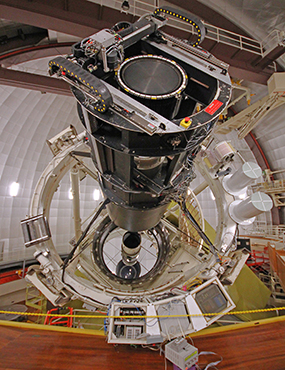105 Delhi Rd, North Ryde
NSW 2113
Global leader in astronomical instrumentation
Australian Astronomical Optics-Macquarie is working at the forefront of astronomical optics. From photonics and positioning systems to astronomy data management and research.
We specialise in developing and using innovative technology, and developing systems for the processing, storage and access of data. Our focus is on the following areas of astronomy:
Our key technology strengths are:
- photonics and other optical-fibre technologies that capture and filter light
- positioning systems that place optical fibres with maximum efficiency
- spectrographs that analyse captured light.
We have pioneered three radically different and world-leading fibre positioning technologies (using pick-and-place robots, spines, and “Starbugs”), as well as collaborated on the development of "hexabundle" fibres for use in integral field spectrographs.
We have built moderate-resolution optical spectrographs and near-infrared spectral imagers.
In collaboration with our partners, we have built the first photonic OH suppression near-infrared spectrographs and made the first on-sky demonstrations of photonic micro-spectrographs.
AAO-Macquarie is also at the forefront of developing an e-research platform and data archive that facilitates cutting-edge science through its Data Central capability.
This platform and data archive provides web-based tools and archive functionality for scientists from a range of disciplines to explore, collaborate and make new discoveries.
AAO-Macquarie is home to a dynamic and diverse research team. Our astronomers collaborate regularly with astronomers across the globe and are recognised leaders in many areas of research.
AAO-Macquarie astronomers are also intrinsically involved with our instrument scientists in producing some of the world's most innovative and ground-breaking instrument technologies.
We're leading or providing leadership in the following survey programs: GAMA, GALAH, Taipan and EMU.
Strategic Plan
AAO is ambitiously bridging eras to shape a future of global leadership in scientific instrumentation and research, driving impact and inspiring the next generation through strategic collaboration and innovation.
- Read our AAO Strategic Plan 2025-2034: Bridging Eras.
- Read our Strategic Plan Overview.
Australian Astronomical Optics (AAO) has seen a lot of change over 50 years, with each iteration of the organisation adding new strengths, building upon its historical foundation of astronomical innovation.
AAO was originally a bi-national facility of the Government of Australia and Government of the United Kingdom from its opening in 1974 until June 2010 (read a brief history).
From 2010 to 2018 AAO was fully owned by the Australian Government.
Since July 2018, the AAO transitioned from Australia’s national optical observatory into two separate entities:
- North Ryde Operations (instrumentation, astronomy research, astronomy data management) — now AAO-Macquarie
- Telescope Operations at Siding Spring — now with Australian National University (ANU) which operates them on behalf of the Australian astronomy community.

Our instrumentation
The AAO instrumentation capability brings to Macquarie a world-wide reputation in telescope instrumentation.
Over its 45 year history as an observatory, it has developed instruments for use with the Anglo-Australian Telescope (AAT) at Siding Spring Observatory in northern New South Wales, and for telescopes around the world.
The early use of optical fibres set the organisation apart in the early 1980s when multi-fibre spectroscopy was transformed from an interesting novelty into a highly productive technique. Once the potential of this technique was demonstrated, the AAO built 2dF, a fibre positioning robot allowing the capture of 400 spectra at once.
In the late 1990s this was an unprecedented development and the scientific surveys that followed provided the worldwide astronomical community with some of its richest data.
Since then, the AAO has built a number of key instruments, including:
- OzPoz in 2003, a fibre positioning robot for the European Southern Observatory’s Very Large Telescope.
- AAOmega in 2006, still one of the world’s most powerful survey spectrographs on the AAT.
- FMOS/Echidna in 2007, a fibre positioning system for the Japanese Subaru telescope.
- SAMI in 2013, a fibre system used to conduct the first major integral field unit survey of nearby galaxies.
- HERMES in 2014, a four-channel fibre-fed spectrograph with high resolution and multi-object capability designed for galactic archaeology.
Meet the dedicated team of people leading AAO-Macquarie.
AAO-Macquarie is both a department within the Faculty of Science and Engineering and a founding partner in the Astralis Instrumentation Consortium(Astralis).
Under the banner Astralis Instrumentation Consortium (Astralis), Macquarie University is partnering with the Australian National University (ANU), the University of Sydney (USYD) and Astronomy Australia Ltd (AAL) to establish a new national capability for astronomical instrumentation. Macquarie University is excited to take a significant role in growing Australia’s global position in astronomical instrumentation.
We work closely in collaboration with our Australian partners. Our Astralis Instrumentation Consortium (Astralis) partners are:
Astralis-AITC
Australian National University, through its Advanced Instrumentation Technology Centre (AITC) within the Research School of Astronomy and Astrophysics.
Astralis-USyd
The University of Sydney, through elements of the SAIL photonics laboratories within the School of Physics.
AAL
Astronomy Australia Limited facilitate access for Australian-based astronomers to the best research infrastructure.
For further information on the Astralis Instrumentation Consortium (Astralis) including our capabilities and current projects visit the Astralis website.
ent here